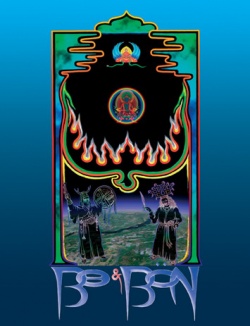Difference between revisions of "The Origin of Bon"
(Created page with "thumb|250px| <poem> According to tradition, Bon originated in the land of Olmo Lungring, located in a larger country known as Tazig. Ol [[symbo...") |
|||
| Line 1: | Line 1: | ||
[[File:B&b_co.JPG|thumb|250px|]] | [[File:B&b_co.JPG|thumb|250px|]] | ||
<poem> | <poem> | ||
| − | According to [[tradition]], [[Bon]] originated in the land of Olmo Lungring, located in a larger country known as Tazig. Ol [[symbolizes]] the unborn; Mo the undiminishing; [[Lung]] the prophetic words of [[Tonpa Shenrab]], the founder of [[Bon]]; and Ring his everlasting [[compassion]]. Olmo Lungring constitutes one-third of the [[existing]] [[world]] and is situated to the {{Wiki|west}} of [[Tibet]]. It is described as an eight-petalled | + | According to [[tradition]], [[Bon]] originated in the land of [[Olmo Lungring]], located in a larger country known as [[Tazig]]. Ol [[symbolizes]] the unborn; Mo the undiminishing; [[Lung]] the prophetic words of [[Tonpa Shenrab]], the founder of [[Bon]]; and Ring his everlasting [[compassion]]. [[Olmo Lungring]] constitutes one-third of the [[existing]] [[world]] and is situated to the {{Wiki|west}} of [[Tibet]]. It is described as an [[eight-petalled lotus]] under a sky which appears as an [[eight-spoked wheel]]. In the center rises Mount [[gYung-Drung Gutseg]], which [[symbolizes]] permanence, indestructibility, and the [[Nine Ways of Bon]]. At the base of [[Mount gYung-Drung]] spring four [[rivers]] flowing towards the four [[cardinal directions]]. The mountain is surrounded by [[temples]], cities, and parks. To the {{Wiki|south}} lies the palace [[Barpo Sogy]]e where [[Tonpo Shenrab]] was born. To the {{Wiki|west}} and {{Wiki|north}} are the palaces in which the wives and children of [[Tonpa Shenrab]] lived. The [[temple]] Shampo Lhatse is to the {{Wiki|east}}. The complex of palaces,rivers, and parks with Mount [[gYung-Drung]] in the center constitutes the inner region of [[Olmo Lungring]]. The intermediate region consists of twelve cities, four of which are aligned with the [[cardinal directions]]. The third region includes what is known as the outer land. These three regions are encircled by an ocean and by a range of snowy mountains. Access to [[Olmo Lungring]] is gained by the arrow way, which takes its [[name]] from an episode in the [[life]] of [[Tonpa Shenrab]] who, before visiting [[Tibet]], is said to have shot an arrow to create a passage through a previously impenetrable mountain range. |
| − | Some [[scholars]] relate this [[traditional]] description of Olmo Lungring to [[Mount Kailash]] and the four great [[rivers]] which spring from its base. Others believe it may refer to the geography of the {{Wiki|Middle East}} and Persia at the [[time]] of Cyrus the Great. To the [[Bonpo]], specific geographic identification is less important than the [[mythological]] origins of their [[religion]]. As [[Lopon Tenzin Namdak]] has pointed out, [[symbolic]] descriptions which combine {{Wiki|history}}, geography, and [[mythology]] are well-known in ancient scriptures. | + | Some [[scholars]] relate this [[traditional]] description of [[Olmo Lungring]] to [[Mount Kailash]] and the four great [[rivers]] which spring from its base. Others believe it may refer to the geography of the {{Wiki|Middle East}} and {{Wiki|Persia}} at the [[time]] of {{Wiki|Cyrus the Great}}. To the [[Bonpo]], specific geographic identification is less important than the [[mythological]] origins of their [[religion]]. As [[Lopon Tenzin Namdak]] has pointed out, [[symbolic]] descriptions which combine {{Wiki|history}}, geography, and [[mythology]] are well-known in ancient scriptures. |
</poem> | </poem> | ||
{{R}} | {{R}} | ||
[http://www.bonfoundation.org/origin.html www.bonfoundation.org] | [http://www.bonfoundation.org/origin.html www.bonfoundation.org] | ||
[[Category:Bön]] | [[Category:Bön]] | ||
Latest revision as of 11:36, 6 September 2013
According to tradition, Bon originated in the land of Olmo Lungring, located in a larger country known as Tazig. Ol symbolizes the unborn; Mo the undiminishing; Lung the prophetic words of Tonpa Shenrab, the founder of Bon; and Ring his everlasting compassion. Olmo Lungring constitutes one-third of the existing world and is situated to the west of Tibet. It is described as an eight-petalled lotus under a sky which appears as an eight-spoked wheel. In the center rises Mount gYung-Drung Gutseg, which symbolizes permanence, indestructibility, and the Nine Ways of Bon. At the base of Mount gYung-Drung spring four rivers flowing towards the four cardinal directions. The mountain is surrounded by temples, cities, and parks. To the south lies the palace Barpo Sogye where Tonpo Shenrab was born. To the west and north are the palaces in which the wives and children of Tonpa Shenrab lived. The temple Shampo Lhatse is to the east. The complex of palaces,rivers, and parks with Mount gYung-Drung in the center constitutes the inner region of Olmo Lungring. The intermediate region consists of twelve cities, four of which are aligned with the cardinal directions. The third region includes what is known as the outer land. These three regions are encircled by an ocean and by a range of snowy mountains. Access to Olmo Lungring is gained by the arrow way, which takes its name from an episode in the life of Tonpa Shenrab who, before visiting Tibet, is said to have shot an arrow to create a passage through a previously impenetrable mountain range.
Some scholars relate this traditional description of Olmo Lungring to Mount Kailash and the four great rivers which spring from its base. Others believe it may refer to the geography of the Middle East and Persia at the time of Cyrus the Great. To the Bonpo, specific geographic identification is less important than the mythological origins of their religion. As Lopon Tenzin Namdak has pointed out, symbolic descriptions which combine history, geography, and mythology are well-known in ancient scriptures.
